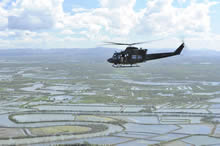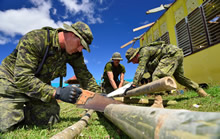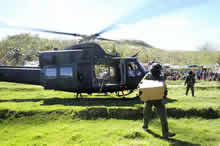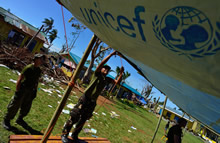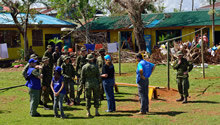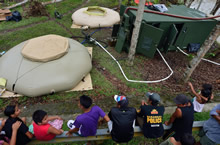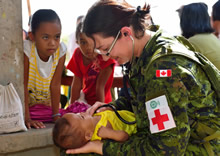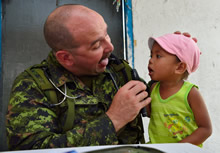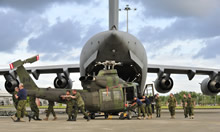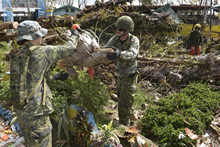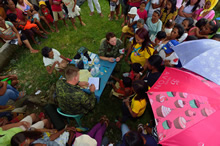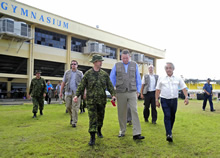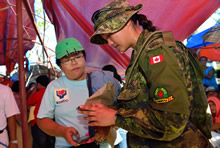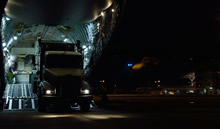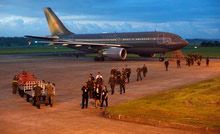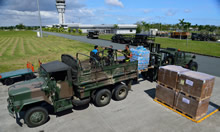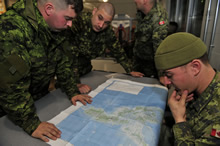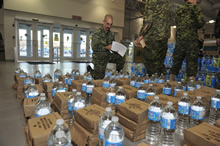Operation RENAISSANCE 13-1
News
There are currently no matching articles. Please check again later.
As part of a Government of Canada response, the Canadian Armed Forces (CAF) provided humanitarian support to the Philippines following a typhoon that hit the country on 8 November 2013.
CAF members began deploying to the region on 13 November 2013 and the mission officially ended on 15 December 2013.
Task Force Philippines
At its height, the CAF task force included 319 personnel with a range of specialties:
- engineering to assist in clearing debris, opening roads, re-establish electricity, remediating washouts and assessing structures such as bridges;
- water purification;
- mobile medical teams that traveled to evacuation centres to treat injuries and identify potential sites for assistance;
- helicopter pilots and crew to extend the reach of personnel to isolated areas and provide reconnaissance and assistance as required;
- air transport and maintenance crews;
- logistics to support the delivery of humanitarian supplies and the daily operations of Task Force Philippines; and
- liaison officers (CAF personnel of Filipino descent) who acted as vital links between local authorities, international aid agencies and CAF members.
Alert: Effects on the ground
By the end of the mission, Task Force Philippines had:
- purified nearly 500,000 litres of water for distribution;
- treated 6,525 medical patients;
- conducted 184 CH-146 Griffon sorties (totalling 357 flying hours) and transported 828 passengers;
- delivered approximately 230,485 pounds of food and 10,325 pounds of shelter and building materials on behalf of non-governmental organizations;
- delivered approximately 59,536 pounds of humanitarian assistance goods on behalf of local authorities;
- cleared 131 km of roads;
- conducted 14 different construction projects; and
- repaired 8 generators.
There were also several assets deployed in support of Op RENAISSANCE 13-1 including:
- 1 x CC-144 Challenger was initially used to transport the Interdepartmental Strategic Support Team (ISST) to the Philippines. The CC-144 then conducted 60 sorties to assist in coordination and reconnaissance in support of the Department of Foreign Affairs, Trade and Development Canada (DFATD) until 30 November;
- 1 x CC-150 Polaris transported members of the Disaster Assistance Response Team (DART) and equipment to the Philippines;
- 3 x CC-177 Globemaster III transported personnel and equipment to the Philippines;
- 3 x CH-146 Griffon helicopters provided mobility, coordination and medical evacuation;
- 1 x Light Support Service Vehicle Wheeled (LSVW) Command Post provided command and control capability;
- 1 x LSVW Ambulance provided mobility to the medical staff and basic level of medical support to the people of the Philippines;
- 2 x LSVW Cargo transported equipment throughout Canadian area of operations;
- 2 x Multi-Purpose Engineering Vehicle (MPEV) provided loading and digging capability;
- 2 x Rough Terrain Fork Lift (RTFL) used to lift heavy loads in austere and rugged environments;
- 3 x Heavy Engineering Support Vehicle with Palletized Load System (HESV + PLS) used to transport heavy loads including the Reverse Osmosis Water Purification Unit (ROWPU);
- 1 x Medium Logistics Vehicle Wheeled (MLVW);
- 3 x ROWPU to provide safe drinking water; and
- 2 x Heavy Logistics Vehicle Wheeled (HLVW) Bowser to support CH-146 operations.
Mission context
On 8 November 2013, Typhoon Haiyan, one of the strongest typhoons ever recorded, slammed into the Philippines setting off landslides, knocking out power in several provinces and cutting communications in the country’s central region of island provinces.
The typhoon caused significant loss of life, a large number of injuries, as well as destruction of property, leaving millions of people requiring humanitarian support.
- 10 November 2013 – the Government of Canada deployed the ISST to the Philippines to help assess the needs of the affected population and identify areas for potential support.
- 11 November 2013 – Prime Minister Stephen Harper directed the deployment of the DART to the region to ensure assets and personnel were nearby and ready to assist at a moment's notice.
- 13 November 2013 – Prime Minister Stephen Harper announced the DART would be sent to Iloilo, Philippines.
- 14 November 2013 – Minister of International Development Christian Paradis announced the area of focus for Canadian relief efforts was in Iloilo and Capiz provinces on Panay Island.
- 15 November 2013 – 50 DART engineers arrive in Iloilo, marking the arrival of the first members of the main body of the DART. Additional DART personnel arrived over the course of the next week.
- 15 December 2013 – The DAR T officially ceases operations. CAF members begin preparing for redeployment to Canada.
- 19 December 2013 – The first DART members arrive in Canada.
Contingency Plan RENAISSANCE
Contingency Plan (CONPLAN) RENAISSANCE is the Canadian Armed Forces’ plan for rapid deployment to the scene of a disaster overseas, as directed by the Government of Canada. It provides direction to the CAF in the event of a decision by the Government of Canada to respond to a request from another nation for help.
The plan delivers a rapid CAF response that is flexible enough to make an immediate positive impact at the scene of the disaster, and to continue helping people as the situation develops.
The Government of Canada’s response to natural disasters abroad is coordinated by the Department of Foreign Affairs, Trade and Development Canada (DFATD) in close partnership with core departments and agencies, including the Department of National Defence and the Privy Council Office (PCO).
Disaster Assistance Response Team
The Disaster Assistance Response Team (DART) is a military organization ready to deploy quickly to conduct emergency relief operations. It is one component of Canada’s toolkit to respond to natural disasters abroad.
Before the DART is fully deployed, an advance party is sent to prepare for the arrival of the main body and DART capabilities which could deploy at a later date.
The DART is a self sufficient, scalable military capability ready to deploy quickly to conduct emergency relief operations for up to 40 days. Its main elements include the DART headquarters, a logistics platoon, an engineer troop, a medical platoon and a defence and security platoon. DART equipment, stores, and supplies are stored at 8 Wing Trenton and are maintained for immediate deployment by a small supporting staff.
The DART is not designed to provide first response services, such as search and rescue or emergency trauma care. Instead, it can be useful where the capabilities of local governments and humanitarian agencies to provide primary health care and potable water are overstretched.
The DART serves three critical needs in emergencies:
- primary medical care;
- engineering help; and
- production of safe drinking water.
External Links
Government of Canada
Canada's Response to Typhoon Haiyan (Department of Foreign Affairs, Trade and Development Canada)
Minister Paradis Extends Typhoon Haiyan Relief Fund (Department of Foreign Affairs, Trade and Development Canada) 2013-11-27
Canada to deploy emergency stockpile in the Philippines (Department of Foreign Affairs, Trade and Development Canada) 2013-11-20
Canada distributes humanitarian assistance for Filipinos affected by Typhoon Haiyan (Department of Foreign Affairs, Trade and Development Canada) 2013-11-19
PM announces further Canadian support for the Philippines (Prime Minister of Canada) 2013-11-18
Canada’s response to Typhoon Haiyan (Prime Minister of Canada) 2013-11-15
PM provides update on Canadian support for the Philippines (Prime Minister of Canada) 2013-11-15
Canada announces further measures in response to Typhoon Haiyan (Citizenship and Immigration Canada) 2013-11-14
PM delivers remarks at the Embassy of the Republic of the Philippines in Ottawa (Prime Minister of Canada) 2013-11-13
Notice – Immigration measures in support of the Government’s response to Typhoon Haiyan (Citizenship and Immigration Canada) 2013-11-13
Canadian Government and Red Cross Deploy Field Hospital and Emergency Medical Teams to aid those impacted by Typhoon Haiyan (Department of Foreign Affairs, Trade and Development Canada) 2013-11-13
Baird Statement on Canadian Response to Typhoon Haiyan (Department of Foreign Affairs, Trade and Development Canada) 2013-11-10
Address by Minister Paradis on Typhoon Haiyan (Department of Foreign Affairs, Trade and Development Canada) 2013-11-10
Statement by the Prime Minister of Canada on Typhoon Haiyan (Prime Minister of Canada) 2013-11-09
Canada supporting those impacted by Typhoon Haiyan (Department of Foreign Affairs, Trade and Development Canada) 2013-11-09
Statement from Minister Paradis and Minister Yelich: Canada is deeply concerned for the people of the Philippines affected by Typhoon Haiyan (Department of Foreign Affairs, Trade and Development Canada) 2013-11-08

